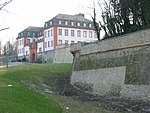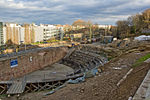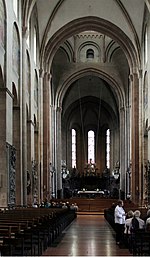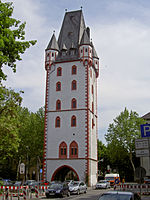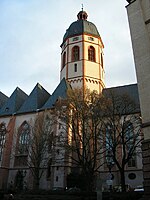Drususstein

The Drususstein (Drusus stone) is a nearly 20 metres high masonry block of Roman origin on the grounds of the citadel of Mainz, Germany. It was originally cased in marble. Researchers now largely accept that this is the structural remnant of the cenotaph mentioned by writers such as Eutropius and Suetonius, erected in 9 BC by Roman troops in honour of the deceased general Drusus, in Mogontiacum (now Mainz). During the early days of the Principate the Drususstein was the starting point for elaborate memorial services in honour of Drusus, and the centre of the imperial cult in Mogontiacum. A procession road linked it to the theatre of Mogontiacum, which contained approximately 12,000 seats, making it the largest known theatre north of the Alps. It may have hosted a part of the annual ceremonies at the day of Drusus' death, and probably also at his birthday.After being robbed of its marble casing in the early Middle Ages, the Drususstein served as a watchtower in the fortifications of the city in the 16th century. For that purpose a staircase and doorframe were made in the structure, which had been up to that point a solid building. Besides the pillars of aqueducts and the stage of the theatre, the Drususstein is one of the few remaining visible reminders of Roman Mogontiacum. Together with the Igel Column, it is the only funerary monument north of the Alps dating from antiquity that remains in its original location.
Excerpt from the Wikipedia article Drususstein (License: CC BY-SA 3.0, Authors, Images).Drususstein
Am 87er Denkmal, Mainz Oberstadt (Oberstadt)
Geographical coordinates (GPS) Address Website Nearby Places Show on map
Geographical coordinates (GPS)
| Latitude | Longitude |
|---|---|
| N 49.992222222222 ° | E 8.2741666666667 ° |
Address
Zitadelle
Am 87er Denkmal
55131 Mainz, Oberstadt (Oberstadt)
Rhineland-Palatinate, Germany
Open on Google Maps
